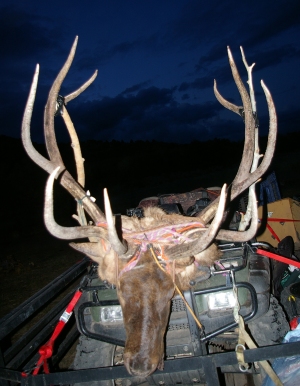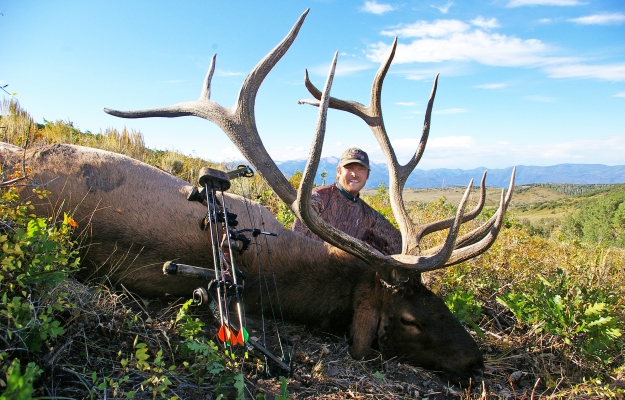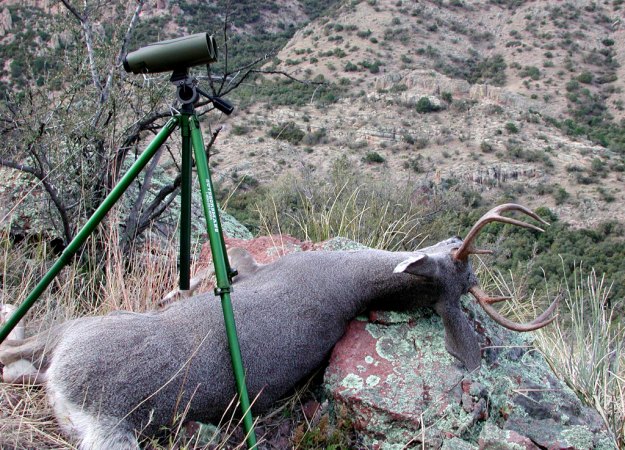Editor’s Note: 43-year-old Mossy Oak Pro Brandon Wicks from Salt Lake City, Utah, is a realtor and a hunting guide. He went elk hunting with his dad before he was old enough to carry a gun, and he took his first elk when he was 14. He hunts elk in Utah, Wyoming and Arizona.
I was hunting a unit in central Utah in the Pavant Mountain Range on a limited-entry elk tag. One of the reasons I put in for this unit was that I had guided in this unit before, and I felt like I knew it relatively well. I knew there were big bulls in this area. The year before I took my bull elk, the new Utah state record for a bull elk taken with a bow came from this unit and scored over 400 inches. The same year that I took my bull, the elk, Spider Buck, was taken with a rifle in a mountain range near where I was hunting in Mount Monroe and was a new world-record elk, grossing over 500 inches and netting just under 500 inches.
In Utah, bowhunting for elk starts around August 20 and goes until about the middle of September. I got my tag only a month before the hunt. Someone had drawn the tag and then wasn’t able to hunt. So, that person turned the tag in, and I was drawn to use that tag. I went down to this unit to scout almost every weekend before the season opened. The first two weeks were really hot, and the elk weren’t responding to calls. All I could do was sit over waterholes and try to make a hunt happen.
I hunted every weekend of the season, and I had some friends come help me scout and try to find a bull to take. Although I had seen the bull that I eventually took about a month before the season started, I never saw him again until the day I took him. During that hunt, we had perfect hunting conditions with cold weather on Labor Day weekend. I had some close calls on several 350-class bulls, but I couldn’t get them where I needed them to be to make the shots.
All my buddies had to return to work on the last week of the hunt, and I decided to move into a new place that wasn’t really hard to get into where I had spotted some bulls. I was hunting by myself, and I would have to carry out whatever I shot. I rode my 4-wheeler into this region. As soon as I turned my 4-wheeler off, I heard bulls bugling all around me and realized I was in the middle of several different bulls. The sun hadn’t even come up yet. So I sat on my 4-wheeler and waited for the woods to lighten up. My game plan was to get as close as I could to what sounded like the biggest bull I could hear.
In the blue light of early morning, I spotted a bull on top of a ridge with a harem of cows. He had his head back in an offensive position, trying to keep the satellite bulls from moving in on his harem of 30-40 cows. As I looked at the bull, I thought he was a giant 5x5, because I couldn’t see his G2 antlers. He had no reason to leave his harem to come to cow calling or even to bugling. Many times I've seen herd bulls with a big group of cows actually try to get those cows away from other bugling bulls, rather than charging in to fight another bull. I could tell this bull was worried about the other bulls that were bugling.
 I decided to hunt him like he was a mule deer – get as close to him as I could and then take the shot. As I drew closer to the bull, I watched him and his herd. Several times I had to cross open ground where the elk could see me. But I had a Montana Decoy’s cow elk decoy, and I would hold it up and walk behind it across those open places to move in closer to the herd. Finally, I reached a spot where I thought the herd would pass by me. I had satellite bulls come really close to me. However, when they got past me on my downwind side, they'd smell me and run off - away from the herd. Although I could hear the herd bull bugle as he closed ground to me, the first elk I saw were cows.
I decided to hunt him like he was a mule deer – get as close to him as I could and then take the shot. As I drew closer to the bull, I watched him and his herd. Several times I had to cross open ground where the elk could see me. But I had a Montana Decoy’s cow elk decoy, and I would hold it up and walk behind it across those open places to move in closer to the herd. Finally, I reached a spot where I thought the herd would pass by me. I had satellite bulls come really close to me. However, when they got past me on my downwind side, they'd smell me and run off - away from the herd. Although I could hear the herd bull bugle as he closed ground to me, the first elk I saw were cows.
I was behind a little ridge that was 50 yards away. So as soon as the elk came over the ridge, I could see them – 20-30 cows, shoulder-to-shoulder, feeding like a giant lawnmower about 30 yards from me. I was concerned that the cows were going to get past me and wind me before I had a shot at the bull. At the same time, I could hear the herd bull bugling closer and closer to me. Once the cows passed me, I could hear the bull bugling about 30 yards from me from behind a big tree. I moved a few yards closer where I would have a clear shooting lane. If the bull stepped out where I thought he would, I’d have a 30-yard shot.
The bull finally stepped out and turned his head away from me at 30 yards. The arrow hit right behind the bull’s shoulder and went straight into his heart. The bull ran 20 yards. I was able to get a second arrow into him. He stopped about 60 yards from me, and I knew that my second arrow was a little low. After the second shot, the bull went about 20 yards and just laid down. When he lay down, I saw how big his rack really was. Instead of being a 5x5, he was actually a 6x6.
I got my 4-wheeler within 30 yards of the downed bull – only about 100 yards from my truck. So I had a really easy time getting the meat and the head out. When I looked closely at this bull’s rack, I realized he was the same bull I had seen a month ago 10 miles from where I took him.
To get John and Denise Phillips’ free cookbook, “Miz Denise’s Outdoor Cooking: More Than 35 Recipes for Elk and Mule Deer,” go to http://johninthewild.com/free-books.
Tomorrow: Brandon Wicks’s Biggest Mule Deer




























